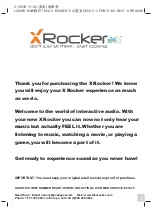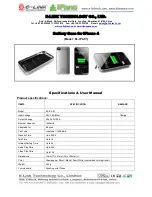
discoverbattery.com
4
3
1.6 Do’s
• Do protect terminals from short circuit before, during, and after installation
• Do wear electrically insulated gloves
• Do use electrically insulated tools
• Do wear eye protection
• Do wear safety toe boots / shoes
• Do handle battery carefully
• Do secure battery safely
1.7 Do Not’s
• Do not add water to the battery
• Do not immerse battery in water
• Do not lift or carry the battery during usage or operation
• Do not operate or store battery outside of operating limits
• Do not short circuit battery
• Do not puncture battery
• Do not expose battery to flames, or incinerate
• Do not open battery case or dissemble battery
• Do not wear rings, watches, bracelets or necklaces when handling or working near battery
• Do not drop or crush battery
• Do not lift battery by the terminal cables
• Do not vibrate battery
• Do not expose battery to water or other fluids
• Do not expose battery to direct sunlight
• Do not dispose of battery
• Do not connect with other types of batteries
• Do not expose battery to high temperatures
• Do not install with other battery types or brands
2. Delivery and Storage
2.1 Receiving and Inspection
• Inspect for missing components.
• Check against the shipping/packing documents.
• Inspect each package or pallet for integrity and electrolyte leakage.
• Record receipt date and inspection data results, and notify your servicing dealer of any damage. Take photographs if
necessary.
2.2 Storage
• Store in a dry, clean, ventilated, cool and frost-free location.
• Do not expose to direct sunlight as damage to the container and cover may occur.
• Do not stack pallets on top of each other and on sharp-edged supports.
• Storage on a pallet and wrapped in plastic material (shrink wrap) is permitted except when room temperature fluctuates
significantly, or when high relative humidity can cause condensation under the plastic. Condensation can cause a whitish
hydration on the terminals to form and result in current leakage and self-discharge.
• Protect against any risk of electric shock from short- circuiting poles/terminals with conductive objects or from the buildup
of conductive dust.
• Maintain the same storage conditions for all batteries within the same batch. Depending upon storage conditions and
temperature, storage time may be limited.
• If lead acid batteries are to be stored for extended periods of time, they must be placed fully charged.
• To prevent over discharge during storage, do not store batteries for more than 6 months at 20°C/68°F or 3 months at
30°C/86°F before performing a re-fresh charge. Failure to observe these conditions may result in significantly reduced
capacity and service life
• Record dates and conditions for all charges during storage.





























